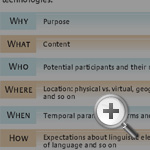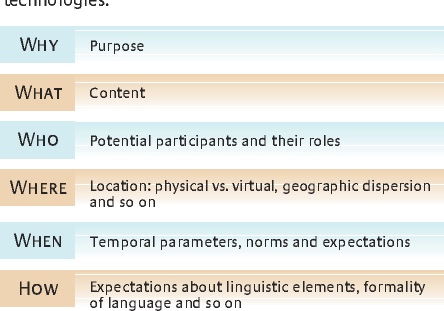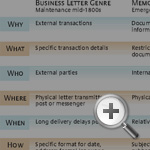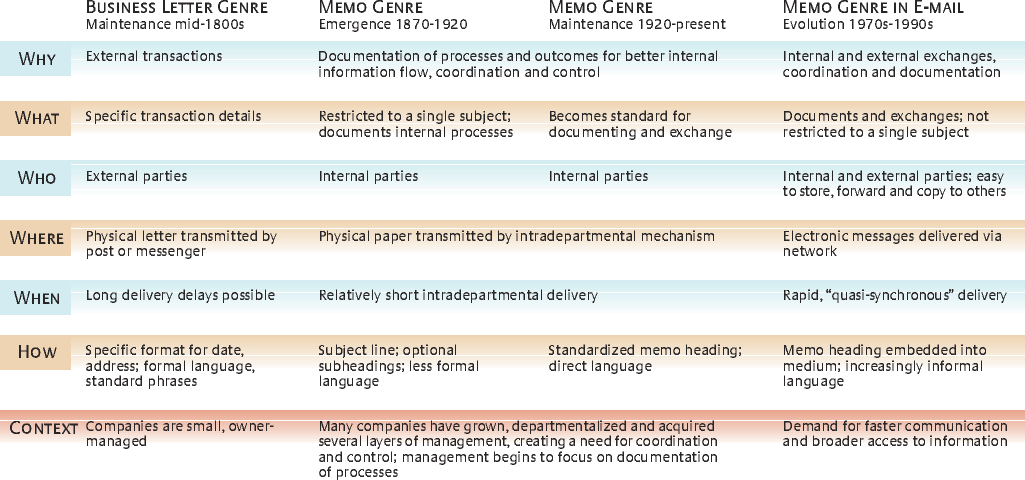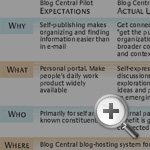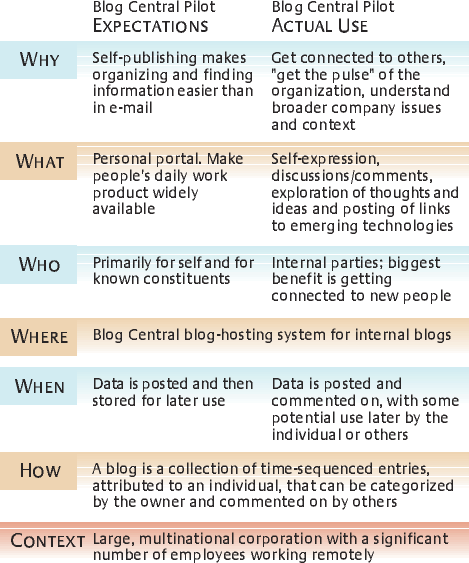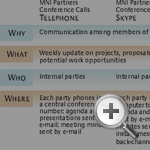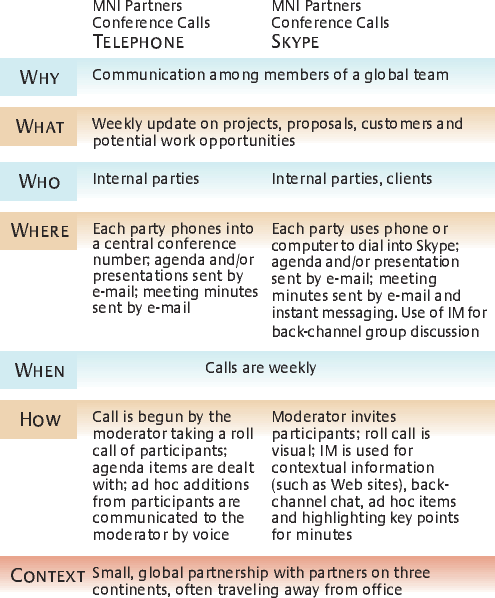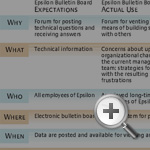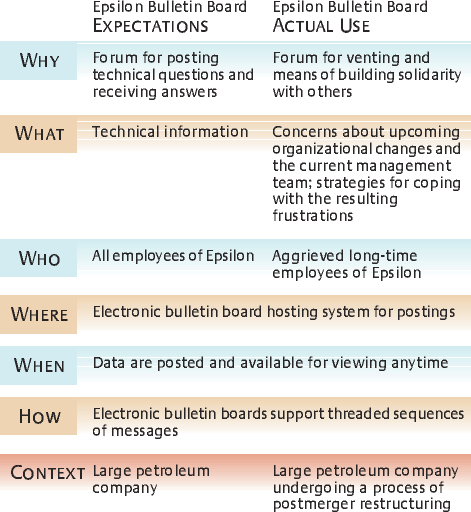The Six Key Dimensions of Understanding Media
The Genre Model can help in evaluating how a new communication technology may fit into your specific corporate environment.
Managers typically dread discovering the next new thing their employees are using. Yet individuals’ pioneering is often the way in which new technologies — blogs, Skype, or electronic bulletin boards, for example — are ultimately merged into an organization’s mainstream, often with significant payoff, although the very same technologies could be problematic to other organizations if adopted wholesale.
In other words, no technology is inherently “right” or “wrong.” Instead, managers must evaluate how it will work in the context of their specific organization. Such an approach allows for the flexibility to change with the times, possibly avoiding the loss of competitive advantage relative to more nimble or tech-savvy companies, while also maintaining control and gaining insights into the technology’s wider implications. Thus a company may choose to adopt, partially or completely, a new technology or, if indicated, to limit or shut down its use.
Our own preferred guide to understanding and evaluating the use of communication technologies in the workplace, and how such use may evolve over time, is called the Genre Model. Based on a methodology developed in academia, this model can help practitioners assess a technology’s potential benefits and risks for their organizations. (See “About the Research.”)
Six Key Dimensions
Management researchers first used the concept of “genre” — a recognizable type of communication — in the 1990s as a way to understand how the paper-based memo developed from the older business letter, how early e-mail users imported a number of paper-based genres into e-mail, and how these new forms began to exhibit some striking changes as e-mail became an increasingly prevalent medium. The speed of communicating, the ease of cc’ing and other e-mail capabilities not only changed the ways in which people used it but also led to the emergence of other new genres. In the dialogue genre, for example, the originator of an e-mail message embeds all or part of a previous message into the current one before responding to it, thereby creating the effect of an oral conversation.
The Genre Model, which identifies both the elements of media adoption and the consequent changes in patterns of user communication, was devel-oped as a tool for evaluating new technology in the context of a specific organization, its goals and its existing media usage. How will the new medium align with the organization’s mission, culture and business practices? How will its use change productivity and effectiveness? Evaluating the medium’s similarity to and difference from existing media, as well as the ways in which employees use and adapt it, can help provide answers to these questions. The Genre Model provides a structure through six key dimensions — why, what, who, where, when and how — for considering the central issues, risks and benefits of a new medium in the context of existing technologies. (See “The Six Key Dimensions of the Genre Model.”)
Why
The lead dimension is why — what is the purpose of the communication occurring in this medium? What are the associated expectations? For instance, when a manager receives a resume, she or he generally assumes that the sender is applying for a position. When assessing a technology that is serendipitously in use in an organization (that is, it wasn’t rolled out by the chief information officer or information technology department), the why question is particularly important. Why are some employees using this new communication technology instead of the already available ones? At first glance, it may appear that the users’ goals are no different from those they could accomplish with existing media. But be alert for subtle differences in purpose. E-mailing, telephoning, instant messaging or walking into someone’s office all can accomplish the goal of communicating with another person, but it’s hard to argue that the nature of these experiences and their effects are identical.
What
The second dimension concerns content — what will be communicated — and the varied expectations about that content with respect to the communication medium. We expect that a letter sent overnight will have important or time-sensitive content. But with new technologies, it is often unclear at first just what kind of content is suitable. Many employees now maintain blogs, for example, and this has often led their organizations to develop guidelines about the type of content that is appropriate (and inappropriate). Deciding what content is suitable for a communication medium is no simple task, however. It requires an understanding of current and potential uses of the medium, some monitoring of use over time and the flexibility to adjust content guidelines accordingly.
Who
The who dimension considers which participants are involved (or could be involved) and their roles — such as sender, primary receiver, secondary receiver, or broker. Communication can be one-to-one, one-to-many, many-to-many or one-to-few, for example, and it can also be broadcast (one-way), interactive (two-way) or some combination. A paper-based memo is used essentially for one-way communication, while many e-mail messages are, or become, part of two-way exchanges. One of the issues with communicating via new technologies like blogs or social networking sites is that many people may see the content even if the creator of an entry aimed it at just a few friends. And e-mail exchanges, for example, may be widely distributed or saved, and even used in legal proceedings. Because actual participants in a communication may differ from the intended participants, it is important when evaluating new technologies to consider not just the intended audience but also the other potential audiences that may be involved, both in the near and long term.
Where
The where dimension pertains to the location of the communication. In face-to-face interactions, senders and receivers of the information are situated in the same physical location, while online communities “reside” in cyberspace. Even with virtual locations, however, the actual whereabouts of participants may still matter. For example, when severe weather cuts electricity or network connections at a particular locale, communications will be affected. Similarly, differences in language and culture, whether corporate or regional, may influence participants’ communication norms. Recognizing the range of locations potentially involved in distributed communication will allow the development of appropriate protocols, schedules and expectations.
When
The when dimension assesses the temporal aspects of communication, such as how quickly to expect a response from someone you’ve called on the telephone. Although these expectations often are not explicitly stated, they typically are understood as such by experienced participants. As we become accustomed to the different capabilities of new media, norms develop accordingly. For example, we assume that a letter sent through the post office will take a few days to be delivered, while we expect an e-mail sent over the Internet to arrive almost immediately (even though the recipient may not see it for hours or even days). Because the use of different communication media shapes different temporal expectations, it is important to recognize and understand the temporal norms that become associated with the use of a new medium — and how these norms may evolve.
How
The how dimension deals with the manner and form in which a communication takes place — expectations of format, language, style and medium. In a traditional paper-based business letter, for example, there is an associated etiquette for its format and structure as well as the formality of the language. Letters sent via e-mail, by contrast, have developed a looser format and structure as well as less formality of language. Evaluating the how dimension can help determine which existing forms are being drawn upon when using a new medium and the ways in which they may change over time.
Analyzing the use, or potential use, of a communication technology through the six key dimensions helps to structure thinking about its application in the context of a specific organization. The Genre Model thus provides a way of understanding how communication in the new medium may be similar to and different from what occurs in existing media. With this information, assessing the likely benefits and risks, as well as potential alignment with organizational goals, norms and culture, becomes possible.
We now turn to a few cases that highlight the use of the Genre Model in analyzing specific changes in an organization’s set of communication technologies.
The Memo’s Emergence and E-mail’s Evolution
The Genre Model helps us understand how genres initially tend to emulate their predecessors, only to grow away from them and ultimately bear offspring of their own. The model helps show, for example, how the paper-based memo emerged and then deviated from the business letter genre, and how e-mail communication initially mimicked aspects of the memo genre (for example, the header information) but then quickly evolved to include a range of new genres, some of which diverged significantly from the memo format.(See “Evolution From Letter to Memo to E-mail.”)
The emergence of the memo, like that of many new genres today, was triggered by a combination of changing social dynamics (larger organizations, new organizational theory) and new technologies (the typewriter, vertical file systems). It is worth noting how long it can take for a communication genre to evolve: The memo emerged over a 50-year period and has been maintained as a useful form of business communication for almost 90 years.
By the mid-1800s, the business letter was an established genre with a rigid set of forms regarding address, date, formalized and polite language (including many standard phrases) and specific greetings and closings. The business letter, used almost exclusively for an owner’s external correspondence with suppliers or buyers, focused on specific transactions and often referenced previous related correspondence. Because the letter was written on paper and transmitted by post or messenger, long distances or bad weather could introduce substantial delivery delays. At that time, there was little need for internal company correspondence (unless, say, a partner was traveling away from the firm’s headquarters and a letter helped bridge the distance), as most companies were small and owner-managed, usually with a single layer of management.
Between 1870 and 1920, companies’ internal correspondence mushroomed in volume and changed in purpose, reflecting the broad socioeconomic changes of the time. By the turn of the 20th century, many companies had grown, departmentalized and acquired several layers of management. To improve efficiency and maintain control, managers developed new approaches and techniques, including the documentation of operational processes and the flow of written communication for internal coordination. Documents were preferred over oral exchanges, usually because they could be stored for future examination and reference, thereby comprising a form of organizational memory.
The memo evolved from this need to create written communication, and the single-subject format of the memo was especially useful for storage (that is, filing) by subject matter. Meanwhile, the introduction of the typewriter in the 1870s allowed companies to speed the production of correspondence, both internal and external. By the 1920s, the format of the memo had evolved into the stable form we use today, with a header containing To, From, Date and Subject information. When addressing colleagues within the company, users gradually adopted less formal and formulaic language. The memo thus evolved through a series of managerial, technological and user advances over half a century.
With today’s emerging digital communication media, we are in an early stage of use, with both the technology and the social norms in considerable flux. The e-mail medium, for example, began by embedding the memo header and other aspects of the memo genre, hence reflecting the genre norms of the memo in every message. However, some of the capabilities of e-mail, being different from those of paper, create new options for usage. For example, e-mail allows for rapid asynchronous exchanges between senders and receivers, potentially bypassing intermediaries such as secretaries. E-mail can be readily distributed and is easier to answer and forward. Similarly, previous messages — in whole or in part — can readily be included in any current message to provide context and continuity. Over time, the language of e-mail has become more informal than that of memos, allowing spelling and grammatical mistakes that would not be tolerated in any official paper-based communiqué.
As the use of e-mail has evolved and norms have somewhat stabilized, most e-mail messages have become significantly different from the memo, just as the memo is now significantly different from the business letter. Yet e-mail may still be used to deliver memo-like messages, as appropriate. When evaluating a new medium in an organization, these borrowings from other genres allow the assessment of communication similarities and differences.
Blog Central in IBM
A more recent new genre is exemplified by the blogging system within International Business Machines Corp., which has a significant proportion of employees working on geographically distributed teams or at client sites. Blog Central was originally piloted at IBM as a self-publishing platform that allowed employees to extract information from e-mail, put it onto the IBM intranet and organize and maintain it — as well as share it with company colleagues — more easily. From its launch in November 2003 through 2006, Blog Central grew to more than 20,000 users, more than 6% of the company.
To assess the ways in which people were interacting with this system, IBM surveyed Blog Central users. The surprising result was that the main advantage wasn’t the exchange of directly practical information but rather its benefit as a professional and company networking tool — making blog entries helped staffers extend their personal network and contribute to an emerging community. They were also using the system to gain perspectives on broader issues within the company as a whole (IBM has over 300,000 employees globally).
The nature of blog communication at the company thus turned out to be significantly different in actual use from what had been expected. (See “Blog Central — Expected and Actual Use.”) A blog is nominally a collection of time-sequenced entries attributed to an individual (the how), but Blog Central had some additional features as well, such as a front page that offered site statistics (most frequently read entry, most commented-on entry and most recent posts, for example). Similarly, the where of Blog Central – on the company’s in-tranet – was a feature that seems to have contributed to the sense of community among the employees despite their geographic separation. (One employee, for example, used the blog as an informal way to keep his remote manager updated.) The when seemed more oriented to current use — serving as the basis of comments and discussion — than to archiving for later reference. The users who emerged, along with the related reasons why they used it, made for a bit of a surprise. People had been expected to post things primarily for their own use or for specific internal constituents. But for many employees, commenting on others’ blogs turned out to be an important activity on the system. Staffers in fact could use the system “to get the pulse of their organization,” as survey respondents put it. Finally, the what also differed from expectations. Blog entries included as much self-expression — thoughts, opinions, ideas — as specific items of information.
Understanding how employees were actually using the system thus turned out to be quite instructive, and IBM management responded by incorporating blogging technology into an IBM Lotus Connections product (which shipped earlier this year).
As the IBM example highlights, it is important to keep track of how a new technology is actually used and how its use changes over time. In that spirit, applying the Genre Model encourages managers to focus on the relationships between what the technology can enable (an important part of the where, when and how of communication), who is using it and what they are using it for (why). The tool is similarly valuable when considering new technology for rollout in the first place. The framework allows not only an assessment of how a new technology’s use may be similar to and different from that of existing technologies along the who, where and when dimensions, but also informed speculation as to how those dimensions might change over time.
Skype in MNI Partners
MNI Partners is a boutique management-consulting company in Newton, Massachusetts, whose clients are generally well-established companies in the United States, Europe and Asia. Because the partners are located on three continents, to keep in close touch with each other they have instituted a weekly conference call that includes an e-mailed agenda and a designated minutes-taker. This meeting generally involves at least an hour’s discussion of current projects, potential new projects/clients and internal operations. But the weekly conference call can become quite expensive, as it requires a conference line with several international lines as well as a regular phone line to allow access to e-mail and the Internet for each participant.
Originally, MNI Partners experimented with using eBay Inc.’s subsidiary’s Skype system as a way to alleviate the communication costs they had been incurring. They found that Skype allowed the partners to avoid using hotel phones, which often have additional charges for international calls, and to avoid cell phones’ roaming charges, which are especially high for international calls. With Skype as the medium for these weekly conferences, MNI Partners lowered its phone-related expenses by almost 70% without much loss in call effectiveness.
Moreover, as the company began using the Skype technology more extensively, the genre of its conference calls began to evolve. (See “The MNI Partners Conference Call.”) In the course of these meetings, the team often discusses a specific company (a client, say, or a potential acquisition target); these interactions can be enriched through the Skype system, as participants can use instant messaging to send each other links to specific Web sites and related information. Also, because these meetings often involve critical decisions about projects, the person taking minutes can get additional and complementary input from the other participants, who highlight key points either in Skype’s main chat channel or through a back-channel one-on-one chat. Not surprisingly, Skype has become the primary medium for the firm’s weekly conference calls.
MNI Partners also has begun using Skype for conference calls with clients, as the back-channel chat feature is particularly useful in a client-facing discussion to keep the conversation on target, ensure that the right points are made at the right time and generally to keep the MNI Partners team on the same page as it interacts with important customers. Although the who, what, when and why of client communication were initially the same across Skype and the telephone medium, the firm’s adaptations in using Skype are gradually changing the how, what, and why of client-facing meetings.
Thus, while the Skype medium was initially adopted as a cost-saving measure, its use by MNI Partners has turned out to be better for the firm’s conference call communications than the previous telephone system. “Even if Skype cost the same as AT&T,” says managing partner Rajiv Srinath, “we’d still use Skype.”
But there are some issues. MNI Partners has observed that voice quality on Skype isn’t always as good as that of a landline, and the system’s current setup allows only four Skype conference-call participants. Moreover, while Skype might be the right telecommunications solution for MNI Partners at this time, it may be the wrong solution for other companies, or even for MNI Partners at a later time. For example, some organizations ban the use of Skype because of security concerns related to the file-sharing capabilities currently so valued by MNI Partners. The challenge, as with all emerging technologies, is to understand how each will work in particular organizations.
Electronic Bulletin Board in “Epsilon”
Another example of a company adopting a new communication technology is the case of a large European petroleum company we’ll call Epsilon, which recently merged with a smaller company in the same industry. In the process of structuring the newly created organization, the information technology department set up an internal bulletin board for use by all employees. Initially intended to help them search for technical support information or post technical questions, the forum quickly developed into a mechanism for sharing grievances. Many long-time employees, it turned out, were frustrated by the nature of the new organizational changes and the lack of respect they perceived from the incoming management team. They began using the new medium to express their concerns about the changes, their disapproval of the new team and the various ways in which management had been implementing the changes. While the nature and course of these changes remained largely unaffected, the forum did allow aggrieved employees to vent their frustrations and gain some sense of solidarity with others who felt similarly slighted by the restructuring process. (See “The Electronic Bulletin Board.”)
>
Concerned about the tenor of discussion on the bulletin board and its growing reputation within Epsilon — most employees signed on to read it every day — management decided to shut it down 20 months after its launch. However, the aggrieved employees, having experienced the communicative value afforded by the electronic bulletin-board medium, promptly started an external forum (hosted by one of the local newspaper sites) and continued their discussions about Epsilon there.
Applying the Genre Model to this case, we can see that the why and how of communicating on the bulletin board evolved substantially beyond initial expectations. But given the troubled climate within the organization, this shift should not have come as such a surprise. The bulletin board provided Epsilon employees with an opportunity to share their ideas throughout the company, and they did just that. Initially, the consequences for management seemed to be less than desirable, and the consequences for the employees more positive, as they were afforded a powerful, cathartic means of expression. Ultimately, however, the electronic bulletin board facilitated the implementation of the very changes the employees railed against, absorbing their frustrations and thereby reducing their motivation to oppose those changes directly.
Mitigating the Risks
The Genre Model allows a careful evaluation of how technologies may work in the context of a specific organization. It provides a structured analytical framework, based on the six key dimensions of why, what, who, where, when and how, for assessing how new communication media may be used and for weighing possible trade-offs between their risks and benefits over time.
The model may be used to compare technologies — whether emerging, under consideration for rollout or operational — with established ways of communicating.2 Although communication evolves with the advent of a new medium, and some risks, such as that of e-mail being used in litigation, become clearer only later, other risks may be evident from the outset. For example, it is readily apparent that blogging entails some loss of corporate control of communications, and many companies have established blogging guidelines as a result. Understanding the nature of the potential changes allows stakeholders to assess whether the benefits outweigh the risks and to take action, if necessary, to mitigate many of those risks.
References
1. J. Yates and W.J. Orlikowski, “Genres of Organizational Communication: A Structurational Approach to Studying Communication and Media,” Academy of Management Review 17, no. 2 (April 1992): 299–326.
2. K. Crowston and M. Williams, “Reproduced and Emergent Genres of Communication on the World Wide Web.” The Information Society 16, no. 3 (2000): 201–202.

